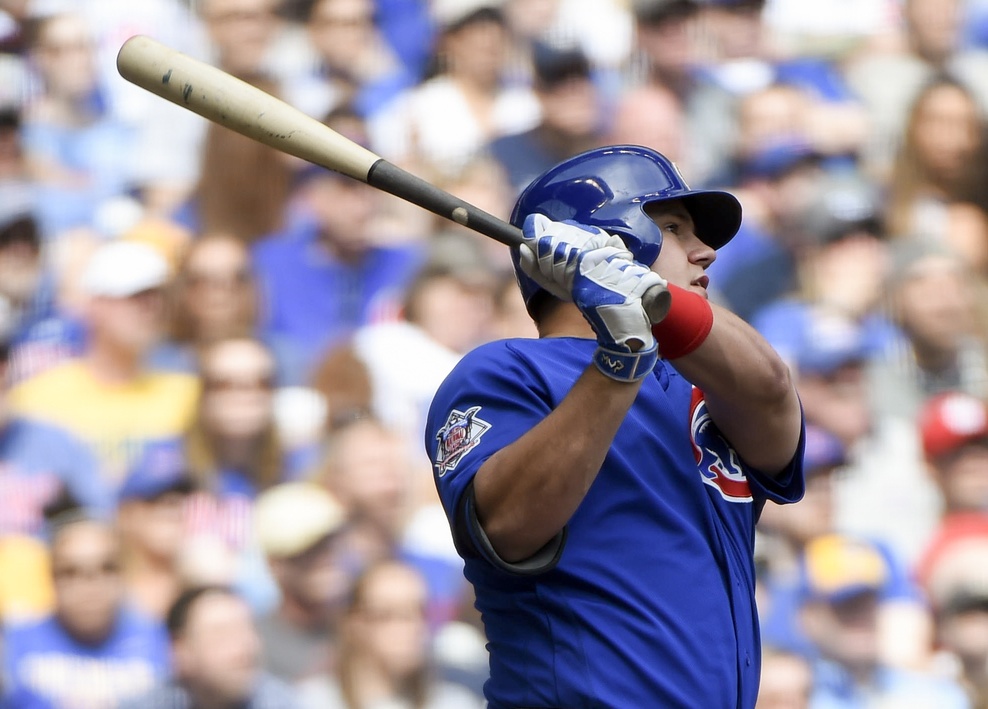It was an interesting thing watching the (I guess you’d call it) fallout from Joe Maddon announcing during the spring exhibition season that Kyle Schwarber would set the table for the Cubs in 2017. While it wasn’t met with a ton of opposition, it has led to countless breakdowns across media outlets and the blogosphere.
That overanalysis ranges all over, from Schwarber’s skill set as a leadoff hitter, to comparisons to Dexter Fowler, to the lack of a speed threat in that spot, and so on. But regardless of the angle, some of which we may touch on here, it’s hard to deny that this is a situation that is absolutely working thus far for Maddon and the Cubs. Not that it should come as any surprise, given that the skill set of Schwarber is exactly why you’d want him there.
At first glance, Schwarber wouldn’t seem like the ideal candidate to lead off for any team, in any league. He’s a big, burly dude who hits for substantial power and isn’t particularly quick. From a prototypical sense, that’s almost the opposite of what you’d come to expect from your no. 1 hitter. But it’s not as if the Cubs were setting the base paths on fire with Fowler in the top spot.
In fact, in his two years in Chicago, Fowler stole a combined 33 bases. That’s likely more than we can expect from Schwarber, but it’s not an overwhelming total that couldn’t be replaced throughout the lineup over the course of 2017. What Fowler brought was an approach and a high on-base presence, reaching base at a rate of .346 in 2015 and an absurd .393 last season.
The low steal totals worked because the Cubs didn’t need a speedster in the top spot in 2016. They needed that approach and those great OBP skills that made Fowler such an effective piece of this offense. And having similar skills made Kyle Schwarber a far more qualified candidate than many might have been willing to give him credit for right off the bat.
As Fowler trudges along through a tough start in St. Louis (sorry, Dex), Schwarber has reached base to the tune of a .382 clip heading into Wednesday evening’s action. He’s only hitting .222, but his batting average on balls in play is also quite low at this point, at .267. That number will likely come up, especially if some of the other figures continue to manifest themselves in the way that they have been.
Immediately upon his arrival to the big league level, Schwarber demonstrated an advanced approach. He saw 4.26 pitches per plate appearance in 2015 and is off to a start in which he’s seeing 4.56. That’s the highest figure in the National League and the second highest in all of baseball. It goes without saying that that’s extremely encouraging. By comparison, Fowler came in at 4.09 in his first year on the North Side and 4.41 last season.
One might like to see his contact rate improve a touch as the season wears on, but a 73 percent mark overall is an improvement from what we saw in 2015 and the brief time he appeared in 2016. Perhaps unsurprisingly, the contact that he is making has been hard. FanGraphs has him making soft contact only 17.6 percent of the time and hard contact at a 35.3 percent rate. A combination of approach and hard contact? What’s not to love about that?
Nothing. That’s what’s not to love about that.
You would find few who argued with the decision to pencil Kyle Schwarber into the leadoff spot. As the game evolves, steals are down overall and there’s less of a need to have a speedster in that position in the order. Most are willing to sacrifice the speed in favor of the approach and consistent ability to get on base. Which made Schwarber ideal and preferable to essentially anybody on this roster. The results are clear so far. He’s seeing a ton of pitches, making hard contact, and reaching base at an extremely high rate.
It’s as ideal a start as the Cubs could have hoped for.
Lead photo courtesy Benny Sieu—USA Today Sports
